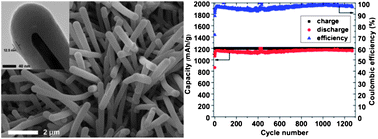Alumina-coated silicon-based nanowire arrays for high quality Li-ion battery anodes†
Abstract
Amongst other requirements, a good anode for Li-ion battery applications must exhibit dimensional stability upon Li insertion, as well as chemical inertness with respect to the electrolyte. This latter characteristic is usually provided by the so-called solid electrolyte interphase (SEI), a passivating film that is formed at the end of the first lithiation step, originating from the partial reduction of the electrolyte and Li salt. However, silicon, which exhibits the highest known capacity for Li alloying, possesses none of the above attributes when used as an anode material. Actually, the large volume expansion of Si upon alloying with Li induces a mechanical instability of the SEI film, which therefore fails to provide its protective role. In this paper, we have studied the effect of thin


 Please wait while we load your content...
Please wait while we load your content...